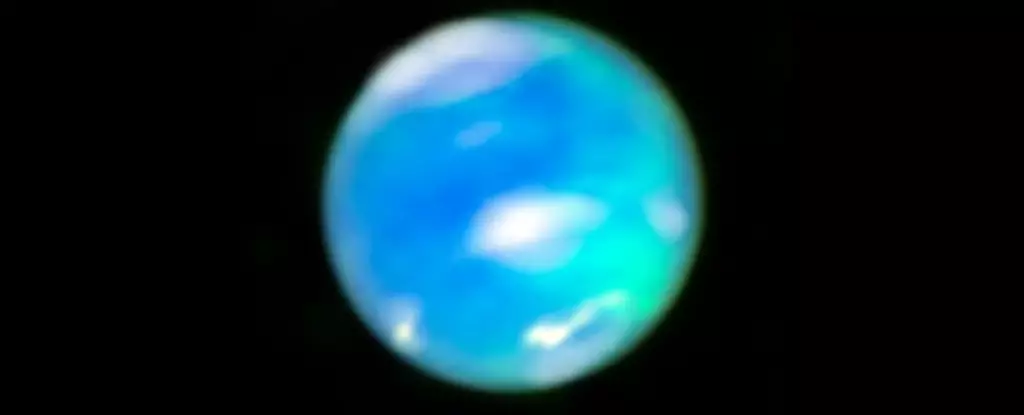In a monumental leap for planetary science, astronomers have illuminated one of the Solar System’s most elusive phenomena: auroras on Neptune. This far-flung ice giant, often overshadowed by the more vibrant displays found on planets like Earth and Jupiter, now embodies a celestial wonder that has only recently been captured in stunning clarity. Utilizing the unparalleled capabilities of the James Webb Space Telescope (JWST), scientists have finally rendered Neptune’s auroral displays in striking near-infrared light, showcasing a phenomenon that offers profound insights into planetary atmospheres and magnetic interactions.
For decades, the presence of auroras on Neptune lingered in the realm of speculation due to its extreme distance from both the Sun and Earth, orbiting at an astounding 30 times the distance of our planet. While other planets have long been observed exhibiting dazzling light shows, Neptune’s auroras remained hidden, challenging our understanding of magnetic field interactions. The JWST’s analysis reveals that Neptune’s auroras are not only present but also distinct in their manifestation, providing a new layer of complexity to our comprehension of such cosmic displays.
The Dance of Solar Particles
Auroras, in essence, are the spectacular outcomes of intricate interactions between solar particles and a planet’s magnetic field and atmosphere. On Earth, this leads to brilliant neon colors dancing across the polar skies as charged particles collide with atmospheric molecules. Jupiter, the king of the planets, presents a different picture entirely, with its auroras appearing as powerful bursts of ultraviolet light, demonstrating both strength and permanence. Interestingly, even our neighboring planets exhibit unique auroras: Mars has its own variations, Venus shows a striking green hue, and Mercury’s versions manifest as X-ray fluorescence bouncing off its mineral-laden surface.
The recent achievement of confirming Neptune’s auroras not only places it on the auroral map of the Solar System but also raises questions about how these features vary among planetary bodies. The ingenuity of the JWST, particularly through its near-infrared spectrometer, has facilitated this unprecedented exploration of Neptune’s atmosphere, yielding a wealth of data that allows us to glean new information about this remote world.
The Role of H3+ in Mapping Auroras
A breakthrough in understanding Neptune’s auroras is the identification of the trihydrogen cation (H3+), a positively charged ion crucial to auroral activity. By measuring the concentration of H3+ across Neptune’s atmosphere, astronomers led by Henrik Melin of Northumbria University were able to create a detailed map of auroral locations. This finding further cements the significance of the JWST’s capabilities in revealing planetary mysteries that have long evaded both ground-based and previous space missions.
Neptune’s magnetic field configuration, however, adds an intriguing twist to the story. Unlike Earth, where auroras predominantly occur near the poles, Neptune’s erratic magnetic field means that the locations of its auroras are concentrated around the equator. This peculiarity underscores the diverse nature of planetary auroras and challenges the conventional wisdom about how solar particles interact with different planetary magnetic fields.
Temperature Gaps and Scientific Revelation
Another fascinating layer to this discovery is the stark contrast between temperature readings obtained from the Voyager 2 spacecraft and those measured by JWST. Voyager 2, which flew past Neptune in 1989, recorded much higher surface temperatures, leading scientists to misinterpret Neptune’s atmospheric characteristics. The recent JWST measurements indicate that Neptune may have cooled significantly since the earlier mission, likely contributing to the difficulty in detecting its auroras. This cooling elevates the critical understanding of how auroral displays can vary even between time spans separated by decades.
This new knowledge isn’t merely an academic interest; it serves as a crucial tool for interpreting auroras not just within our Solar System but in the broader context of exoplanets orbiting distant stars. Understanding auroras in one realm provides a template for exploring the atmospheric dynamics of other worlds, opening the door to broader questions about their habitability and conditions.
By revealing Neptune’s auroras, scientists have not only charted new territory in planetary science but also woven the threads of a larger cosmic tapestry that connects us to far-flung worlds. Each illumination of Neptune’s atmosphere enhances our understanding of the fundamental forces at play in our universe, illustrating that even the most subdued planets harbor unseen wonders waiting to be unveiled.

